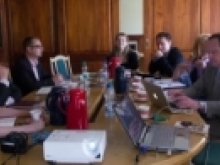
Kielce
The City of Kielce has about 200.000 inhabitants and a size of 109km². It is situated in the South-Eastern part of Poland. It’s the capital of Swietokrzyski region.The City initiated creation of an informal Kielce Metropolitan Area /KMA/ in 2005, which is composed of 11 surrounding municipalities, yet it is not recognized by Polish law. The municipal members of KMA are ready to undertake common actions in order to change that state-of-art focusing on addressing common challenges: sustainable economic development via services, hi-technologies, tourism, which will go together with decreasing traffic jams, air pollution and increasing the livability of the City. There are many interdependencies between Kielce and surrounding communes. Kielce offers most of the jobs, it serves the cultural, educational, recreational needs of the population living in the City and in the neighborhood, on the other hand, inhabitants of Kielce have drinking water from the surrounding municipalities and they often spent weekends in the forests or near lakes, which surround Kielce
Contact:
Dorota Lasocka
The population of Kielce Metropolitan Area is 326 005 of inhabitants. It is also the capital of Polish construction business and the 2nd largest trade center in Poland. The City has the potential to be the tourist center of at least national meaning if connected with the region rich in the natural beauty. 1/3 of the area of the City of Kielce is a green area and there are 5 natural reserves within the borders of the City. The Kielce City is the regional academic centre with 60.883 students (2007/2008) on 14 higher educational schools and also the scientific centre.
Main challenges for the city and its hinterland:
- In order to keep and give back the special environmental character of Kielce, there is the need to allow just pro-ecological investments;
- Creating a system of eco-management for Kielce-Kielce Metropolis-Region;
- Development of a garbage management – especially segregation and recycling.
- Improvement of the transport infrastructure (location far from main transport routes + rather bad technical state of roads; lack of airport; etc.)
- Need for a transfer from traditional market based on old-fashioned industry and high rate of employment in the public finance sector to modern economics.
SOME RELATED NETWORKS
JOBTOWN
JOBTOWN
A European Network of Local Partnerships for the Advancement of Youth Employment and Opportunity
CityRegion.Net
CityRegion.Net
Develop new structures and tools that make it possible to improve collaboration on the "city-region" level.
Latest activities
News
Lead Expert Study Visits are going on well and frantically
After Enfield, Thurrock, Aviles, Gondomar and Aveiro, Ian Goldring visited Kielce (Poland) and Kaiserslautern (Germany).



